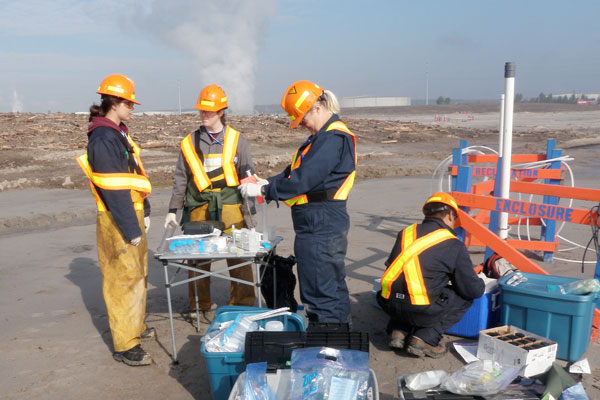LASSONDE INSTITUTE
Our INdustry Partnerships
Canadian Mining Leadership for Canada’s Vital Resources Industry
Located in the heart of Toronto, the mining finance capital of the world and home to more than 1,600 mining company headquarters, the Lassonde Institute of Mining is uniquely situated to strengthen our strategic partnerships with industry while maximizing impact and providing training opportunities for our students.
Our industry partners work closely with our researchers and students, and leverage their investments in research (by as much as a three times) through a variety of government matching programs, including the Natural Sciences and Engineering Research Council and the Ontario Centres of Excellence. This enables industry to achieve the greatest possible impact and return on investment on collaborative projects.
Water & Tailings
Global water resources are under increasing pressure. Tailings disasters affect us all. Society expects us to protect the planet. Let's tackle these challenges together.
Improved Environmental Performance & Closure Strategies
Industry Challenge
Every year mines use 7 to 9 billion cubic metres of water to extract desired elements from raw ore, resulting in large volumes of tailings. Tailings ponds are often black boxes containing largely undescribed bacteria and other microorganisms that thrive on mineral wastes and drive chemical reactions that can lead to acidification, toxicity and oxygen consumption.
Innovation & Real-World Impacts
Unravelling the roles played by microbes in wastewaters geochemical processes allows companies to effectively manage and monitor while lowering costs and environmental risks.
Through the application of genomics with comprehensive geochemical analyses and modelling of micro-organisms to wastewaters, robust decision-making frameworks and accurate monitoring technologies have been designed.
Professor Lesley Warren, PhD
Warren has spent decades working with the extractive resources sector to shed light on the advantages of using microorganisms to clean up mine sites. Over the years, her partners have included: Syncrude Canada, Glencore, Vale, Hudbay, Rambler as well as the Ontario Mining Association, NRCan and the Mining Association of Canada.
Cleaning Hard-to-Access Underground Reservoirs of Pollutants Naturally and Safely
Industry Challenge
Benzene, toluene, ethylbenzene and xylene, collectively known as BTEX, are major contaminants resulting from extraction, transportation and refining processes which frequently pollute groundwater. Their removal from soil and wastewater can be expensive and time consuming for industry.
Innovation & Real-World Impacts
Developing and delivering bio-remediation strategies and monitoring tools tackle and destroy BTEX chemicals. Lab-grown microorganisms can be added back to the soil to speed up the natural process of degradation. From transforming mining waste into new products and creating bio-based plastics from fuels, this research takes harmful materials and re-imagines their application.
Professor Elizabeth Edwards, PhD
Edwards translates her research from lab to marketplace through a partnership with SiREM, an environmental consulting company. The company currently sells KB-1. KB-1 is a culture Edwards developed for degrading chlorinated compounds, such as those formerly used in dry cleaning, to help remediate sites worldwide. They are now looking to do the same with the BTEX cultures..

Finding Value in Mining Wastewaters and Tailings
Industry Challenge
Mining companies need to address cleaning-up mine wastewater, recovering by-products from the mining process, and increase the sustainability of industrial operations.
Innovation & Real-World Impacts
New technologies to remediate and recover value from tailings including Hybrid Forward Osmosis-Freeze Concentration successfully combines forward osmosis to recover water and freeze concentration to recycle chemicals. This novel process significantly lowers the energy input and freshwater intake in industrial operations.
Professor Vlad Papengelakis, P.Eng, PhD
In partnership with Vale, Papangelakis and his team employed biohydrometallurgy to decompose pyrrhotite tailings in a Sudbury mine and recover metals such as nickel and sulfur. The remediation of the tailings offset the value of the cleanup costs by recovering value through the pyrrhotite byproducts.
Your content goes here. Edit or remove this text inline or in the module Content settings. You can also style every aspect of this content in the module Design settings and even apply custom CSS to this text in the module Advanced settings.

